Physical Address
304 North Cardinal St.
Dorchester Center, MA 02124
Recapitulates relevant facial anatomy for proper clinical assessment and surgical planning.
Discusses the diverse etiology, the clinical presentation, and potential secondary complications associated with facial paralysis.
Emphasizes a thorough and focused assessment of the functional, psychosocial, and aesthetic consequences of facial paralysis.
Outlines treatment concepts, realistic therapeutic goals, and describes surgical key procedures in detail.
Access video and video lecture content for this chapter online at Elsevier eBooks+ ![]()
![]()
Facial paralysis is defined as an acute or chronic facial nerve dysfunction resulting in weakness of facial muscles responsible for emotional expression, speech, and protection of the vulnerable ocular surface. However, loss of facial nerve function affects the patient’s daily life in multiple ways. Proximal facial nerve lesions located within the temporal bone may affect the parasympathetic facial nerve fiber population that supplies lacrimal and salivary glands as well as the taste receptors in the anterior two-thirds of the tongue. Parasympathetic facial nerve fiber dysfunction thus may result in insufficient lacrimation and salivation, “crocodile tears”, gustatory sweating, and impaired taste. However, the arguably most debilitating dysfunction for most patients’ daily life and their social interactions is the loss of facial expression. Facial paralysis not only results in impaired dynamic expression, disabling the patient to express emotions, spontaneously react to emotional stimuli, and formulate clear speech in daily social interactions, but also in a decreased static muscle tone, resulting in stigmatizing disfigurement. The clinical management of these patients aims at restoring or replacing lost muscle function and thereby alleviating symptoms and preventing secondary complications. Given the multifaceted clinical picture of facial paralysis, meaningful clinical assessment and successful surgical management rely on detailed knowledge of the facial anatomy and function.
The facial nerve, as cranial nerve VII, courses from the brainstem through the temporal bone, passes between the superficial and deep portions of the parotid gland and terminates in multiple branches supplying the facial musculature. Based on its course, it can be divided in an intratemporal and an extratemporal portion. The intratemporal portion courses though a narrow bony channel and is thus challenging to access for surgical intervention. The extratemporal portion of the facial nerve begins at the stylomastoid foramen. It is in a deep position below the earlobe but becomes more superficial before it passes through the parotid gland. Here it branches into two main trunks which then further divide within the substance of the gland. Several distinct branching patterns of the facial nerve have been described. Usually, five branches can be distinguished: frontotemporal, zygomatic, buccal, marginal mandibular, and cervical. On leaving the parotid, the facial nerve may have 8 to 15 branches. Distally, there is further arborization and plexiform axonal interconnection between these branches ( Fig. 15.1 ). Thus, the larger, proximal nerve branches may share a substantial functional overlap. For example, a single zygomaticobuccal branch may supply innervation to the orbicularis oculi as well as to the orbicularis oris. This is of particular importance for facial nerve transfer surgery.
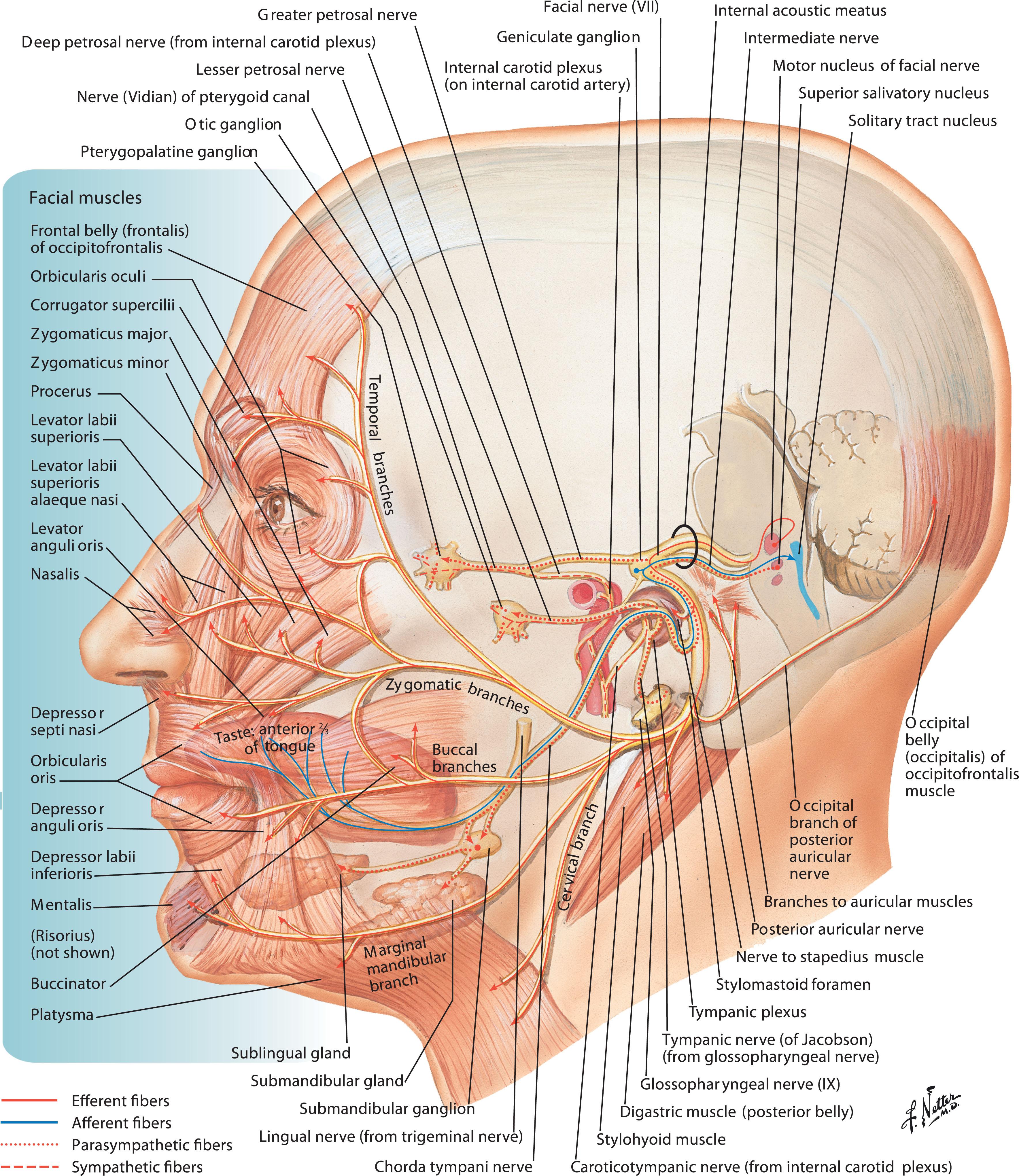
The temporal division of the facial nerve consists of three to four branches that run obliquely along the undersurface of the temporoparietal fascia after crossing the zygomatic arch 3–5 cm lateral from the lateral orbital margin. The lower branches run along the undersurface of the superior portion of the orbicularis oculi for 3–4 mm before entering the muscle to innervate it. The upper two branches usually enter the frontalis muscle at the level of the supraorbital ridge up to 3 cm above the lateral canthus. The nerves usually course approximately 1.6 cm inferior to the frontal branch of the superficial temporal artery. Because there is relatively little adipose tissue at the lateral border of the frontalis muscle, those nerve branches lie virtually subcutaneous making them susceptible to injury.
The zygomaticobuccal division of the facial nerve consists of five to eight branches supplying the lip elevators as well as to the lower orbicularis oculi, orbicularis oris, and buccinators. These branches often share motor targets so that one or more branches can usually be divided and transferred to a new target without causing noticeable weakness. Suitable branches can be reliably identified by functional facial nerve mapping. Of note, these nerves lie deep near the parotid–masseteric fascia in the same plane as the parotid duct.
The marginal mandibular division of the facial nerve consists of one to three branches, whose course begins up to 2 cm below the ramus of the mandible and arcs upward to cross the mandible halfway between the angle and mental protuberance. The branches lie on the deep surface of the platysma and cross superficial to the facial vessels approximately 3.5 cm from the parotid edge. Usually, separate branches can be distinguished to the depressor angularis, depressor labii inferioris, and mentalis, and a variable superior ramus supplying the upper platysma and lower orbicularis oris.
The cervical division of the facial nerve consists of one branch that leaves the parotid gland well below the angle of the mandible and runs on the deep surface of the platysma, which it innervates by entering the muscle at the junction of its cranial and middle thirds. This point of entry is approximately 2 or 3 cm caudal to the vascular pedicle of the platysma.
The facial nerve innervates 17 paired facial muscles and one unpaired oral sphincter muscle, the orbicularis oris ( Fig. 15.2 ). The subtle movements that convey facial expression require coordination between all these muscles.
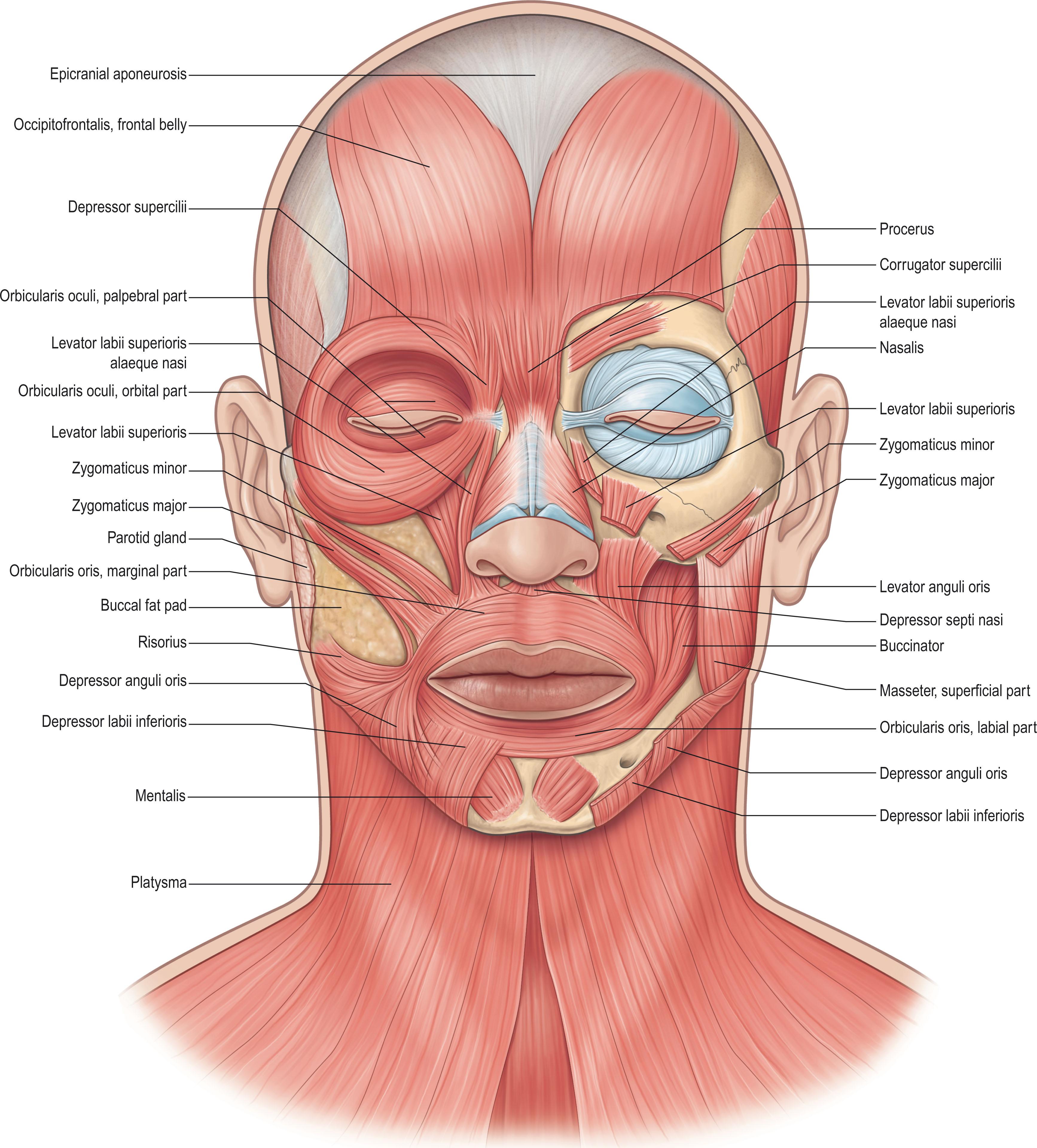
The main muscles involved in forehead and eyelid animation are the frontalis, corrugator, and orbicularis oculi. For the lower half of the face, two antagonistic muscle groups control the movement of the lips. The lip retractors including the levator labii superioris, levator anguli oris, zygomaticus major and minor for the upper lip, and depressor labii inferioris and depressor anguli oris for the lower lip. The antagonist of these lip-retracting muscles is the orbicularis oris, which is responsible for oral continence and some expressive movements of the lips. The mimic muscles are arranged in four layers. The depressor anguli oris, part of the zygomaticus minor, and the orbicularis oculi are the most superficial, whereas the buccinators, mentalis, and levator anguli oris make up the deepest layer. Except for the three deep muscles, the motor nerve branches of all other facial muscle branches enter the deep muscle surface. The muscles that are clinically important or most often require surgical management in patients with facial paralysis are the frontalis, orbicularis oculi, zygomaticus major, levator labii superioris, orbicularis oris, and depressor labii inferioris.
The frontalis muscle is a bilateral, broad sheet-like muscle 5–6 cm in width and 1 mm in thickness. The muscle takes origin from the galea aponeurotica at various levels near the coronal suture and inserts onto the superciliary ridge of the frontal bone and into fibers of the orbicularis oculi, procerus, and corrugators supercilii. It is firmly adherent to the skin through multiple fibrous septa and glides over the underlying periosteum. The two muscles fuse in the midline caudally, often in a fibrous junction. The frontalis is essential to elevate the brow and its tone at rest keeps the brow from descending. This tone may be lost in facial paralysis, which causes the brow to fall and potentially obscure upward gaze.
Upper eyelid opening is performed by the levator palpebrae superioris muscle innervated by cranial nerve III and the Müller muscle innervated by the sympathetic nervous system. Eyelid closure is performed by the orbicularis oculi muscle that acts as a sphincter. The orbicularis oculi muscle is a continuous muscle with three subdivisions: a pretarsal division covering the tarsal plate, a preseptal division overlying the orbital septum and the orbital division forming a ring over the orbital margin. The pretarsal and preseptal divisions function together when a patient blinks, whereas the orbital portion is recruited during forceful eye closure and to lower the eyebrows. Of note, the preseptal portion of the orbicularis oculi is under voluntary control, whereas the pretarsal is involved in reflex movements.
The pretarsal orbicularis oculi overlies the tarsal plate of the upper and lower eyelids. The tarsal plates are thin, elongated structures of connective tissue that support the eyelids. The superior tarsal plate is 8–10 mm in vertical height at its center but tapers medially and laterally, whereas the inferior tarsal plate is 3.8–4.5 mm in vertical height. The skin overlying the pretarsal orbicularis is one of the thinnest in the body and is adherent to the muscle over the tarsal plate. The skin over the preseptal and orbital regions is laxer and more mobile and becomes thicker over the orbital part of the muscle. The preseptal orbicularis oculi muscle portion provides support to the orbital septa and is more mobile except at the medial and lateral canthi, where the muscle is firmly attached to the skin. The orbital portion of the orbicularis oculi extends in a wide circular fashion around the orbit. It originates medially from the superomedial orbital margin, the maxillary process of the frontal bone, the medial canthal tendon, the frontal process of the maxilla, and the inferomedial margin of the orbit. In the upper eyelid, the fibers sweep upward into the forehead and cover the frontalis and corrugator supercilii muscles; the fibers continue laterally, superficial to the temporalis fascia. As a superficial mimic muscle, the orbicularis oculi lies over the origins of the zygomaticus major, levator labii superioris, levator labii superioris alaeque nasi, and part of the origin of the masseter muscle. There are multiple motor nerve branches that supply the upper and lower portions of the orbicularis oculi, and these enter the muscle just medial to its lateral edge.
The three major lip elevators are the zygomaticus major, levator labii superioris, and levator anguli oris ( Table 15.1 ). The zygomaticus muscles move the commissure at an angle of approximately 45°, the levator anguli oris elevates the commissure vertically and medially, and the levator labii superioris elevates the lip vertically and laterally to expose the upper teeth. The zygomaticus major takes origin from the lower lateral portion of the body of the zygoma; the orbicularis oculi and zygomaticus minor cover its upper part. Its course is along a line roughly from the helical root of the ear to the commissure of the mouth, where it leads into the modiolus. The modiolus is the point of common attachment at which the fibers of the zygomaticus major and minor, orbicularis oris, buccinator, risorius, levator anguli oris, and depressor anguli oris come together. Deep fibers of the zygomaticus major are angled upward from the modiolus to fuse with the levator anguli oris, whereas caudal fibers continue into the depressor anguli oris. The main nerve to the zygomaticus major enters the deep surface of the upper third of the muscle.
| Muscle | Length (mm) | Width (mm) | Thickness (mm) |
|---|---|---|---|
| Zygomaticus major | 70 | 8 | 2 |
| Levator labii superioris | 34 | 25 | 1.8 |
| Levator anguli oris | 38 | 14 | 1.7 |
The levator labii superioris originates along the lower portion of the orbital margin above the infra-orbital foramen. The muscle courses inferiorly, partially inserting into the nasolabial crease. The lateral fibers pass inferiorly into the orbicularis oris, and the deepest fibers contribute to the modiolus. The motor nerve first passes underneath the zygomaticus major muscle and then enters the levator labii superioris on its deep surface.
The levator anguli oris is the third lip elevator. It takes origin from the maxilla below the infra-orbital foramen and inserts into the modiolus. As this muscle belongs to the deepest layer, it is innervated through its superficial surface by the same nerve branch that innervates the buccinator.
The orbicularis oris is a complex muscle that functions as a sphincter of the mouth, serves to pucker and purse the lips. Anatomically, the orbicularis oris muscle consists of two parts, superficial and deep. The deep layers of the muscle encircle the orifice of the mouth and function as a constrictor. The fibers of the superficial component can contract independently to provide expression. The orbicularis oris also builds the bulk of the lip, with skin overlying it superficially and mucous membrane being attached on its deep surface. Philtral columns are formed by the insertion of the orbicularis, and a portion of levator labii superioris, into the skin. The levator labii superioris fibers reach the philtral columns by coursing above the surface of the orbicularis oris to insert into the lower philtral columns and vermilion border as far medially as the peak of Cupid’s bow.
The lower lip depressors consist of the depressor labii inferioris, also known as the quadratus labii inferioris, and the depressor anguli oris, also known as the triangularis ( Fig. 15.3 ). The mentalis, however, is not a lip depressor and instead elevates the lip indirectly. The depressor labii inferioris arises from the lateral surface of the mandible, which is inferior and lateral to the mental foramen. It runs medially and superiorly to insert into the lower border of the orbicularis oris and its surface. Through fibrous septa, it attaches to the vermilion and the skin of the middle third of one side of the lip. Its action is to pull the lower lip downward and laterally and to evert the vermilion (e.g., as in showing the lower teeth). The depressor anguli oris depresses the angle of the mouth (e.g., in frowning) and arises from the mandible laterally and is superficial to the depressor labii inferioris. The medial fibers insert directly into the skin at the labiomandibular crease; the remainder blend into the modiolus.
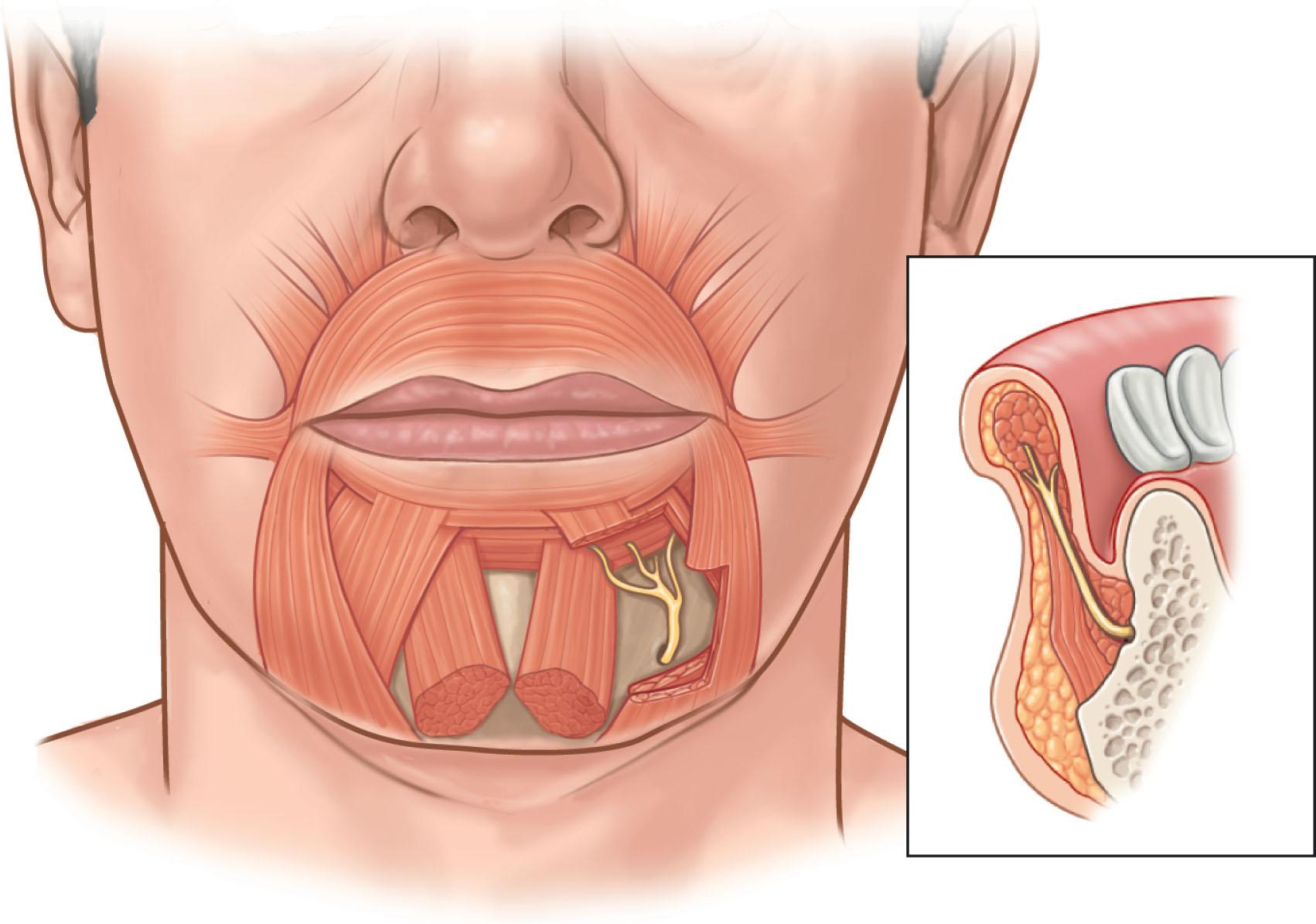
Functioning facial muscles are vital for protection of the susceptible ocular surface, nasal airway maintenance, oral continence, facial symmetry, emotional expression, and clear speech. Facial paralysis thus creates a multifaceted clinical problem with severe functional disabilities that often affect the patient’s self-image, as well as social interactions of those afflicted and their families ( Fig. 15.4 ).
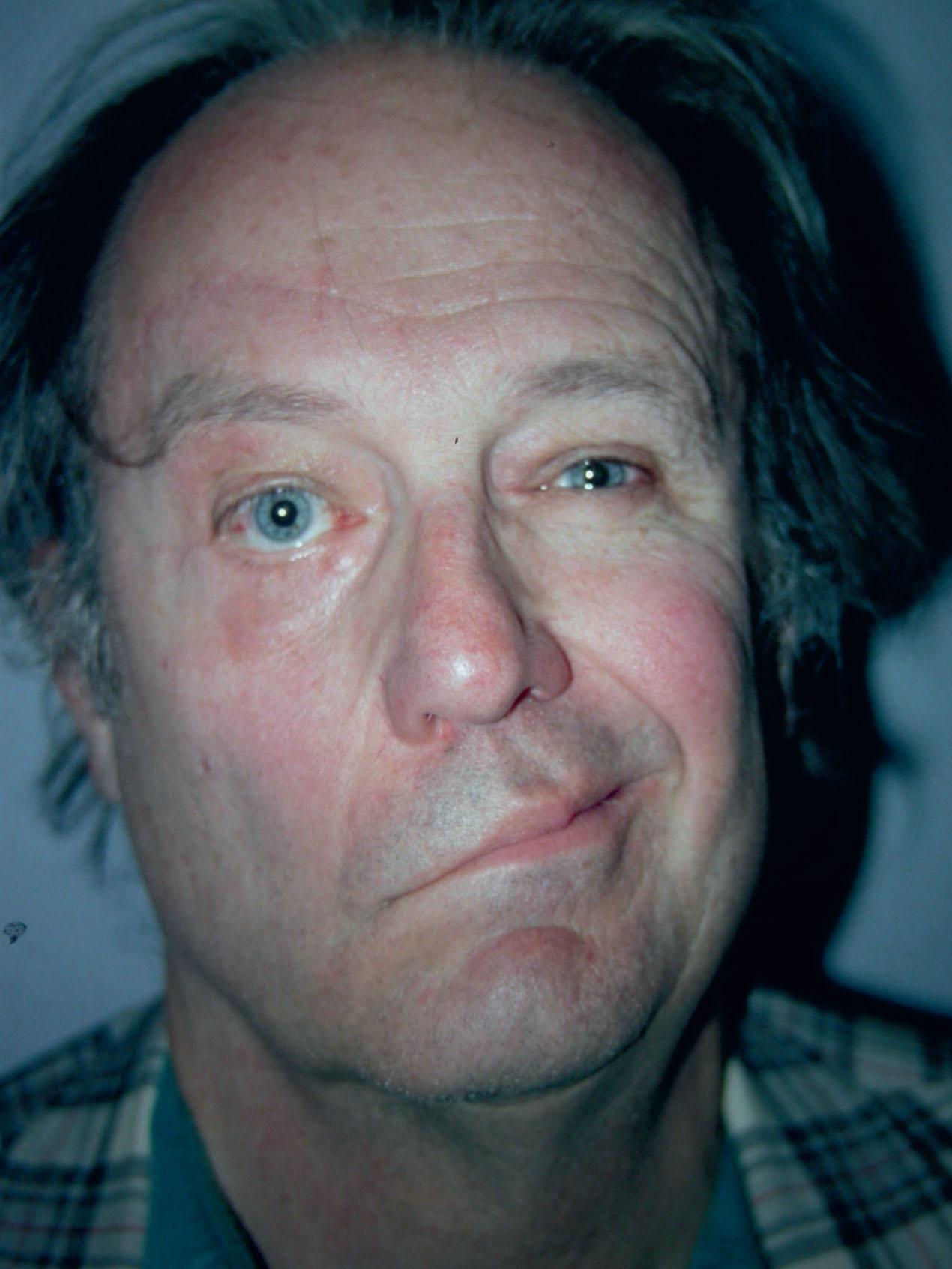
Facial paralysis may affect the frontalis muscle and orbicularis oculi muscle. Dysfunction of the frontalis muscle leads to brow ptosis as commonly seen in older patients. The weight of the forehead tissue can cause sagging of the eyebrow inferiorly over the superior orbital margin, which results in facial asymmetry that may give the impression of unhappiness and obstruct the upward gaze. Asymmetries can be aggravated by overactivity of the contralateral frontalis muscle.
Dysfunction of the orbicularis oculi muscle may cause incomplete lid closure, and insufficient tear film distribution and drainage, resulting in loss of protection for the susceptible ocular surface. A healthy and adequately lubricated ocular surface is essential to the refractive function of the cornea and protects the deeper ocular compartments from pathogen penetration. Physiologically, when the eyelids are open, the distance between the upper and lower eyelid is 9–11 mm at its widest point. In the neutral gaze position, the upper eyelid covers 2–3 mm of the superior corneal limbus; the lower eyelid lies at the level of the inferior corneal limbus. Thus, there is normally no sclera showing. With eye closure, most movement occurs in the upper eyelid while the lower lid remains relatively static. Thus, the main function of the inferior orbicularis oculi is the maintenance of lid margin contact with the globe and assistance with tear drainage. However, with squinting or smiling, there may be up to 2 mm of upward movement in the lower eyelid. Patients with facial paralysis and insufficient lid closure are often troubled by significant discomfort in the eye because of prolonged corneal exposure and desiccation. Corneal dryness stimulates reflex tearing, but excessive tears are usually poorly managed by the paralyzed eyelids, resulting in overflow. Therefore, patients with dry eyes may present with excessive tearing, often exacerbated by downward inclination of the face (e.g., during reading). With the passage of time, the lower eyelid may develop an ectropion, causing the inferior lacrimal punctum to pull away from the eye. An ectropion further impairs tear drainage and increases the risk of excessive corneal exposure.
Further, paralysis of the periocular muscles widens the palpebral aperture of the eye in facial paralysis patients, rending it unable to convey expression. For example, when the patient smiles, the paralyzed eyelids remain open instead of slightly closing.
The inability to control their lips is another major concern for patients with facial paralysis. This affects the patient’s ability to speak, eat, and drink properly. For example, many patients with facial paralysis have difficulty producing b and p sounds. Paralysis of the orbicularis oris results in drooling and difficulty in controlling the mouth (e.g., drinking from a glass). Buccinator paralysis leads to problems in the control of food boluses. Food tends to pocket in the buccal sulcus of the paralyzed portion of the face; therefore, many patients chew only on the contralateral side. Paralyzed perioral muscles also severely affect facial expression with an inability to smile.
Facial paralysis should not be regarded as an aesthetic issue. The lost ability to smile and convey emotions is a functional disability that directly impairs non-verbal communication thereby affecting social interaction and quality of life. Patients often present obvious asymmetry at rest, exacerbated by an attempt to express emotions and smile, which leads to high levels of appearance-related distress ( Fig. 15.5 ). Accordingly, the prevalence of psychological disorders is significantly higher in patients with facial paralysis compared to the general population, with approximately one fourth of the patients suffering from anxiety or depression, respectively. The objective clinical severity of facial paralysis, however, is not predictive for psychosocial distress; instead, specifically the impaired ability to smile is a predictor for anxiety (R 2 = 0.4) and depression (R 2 = 0.35) in patients with facial paralysis. Further, particularly women and young patients are at risk of suffering from condition-related psychosocial distress. Consequently, all patients presenting with facial paralysis should be screened regardless of condition severity. Brief self-administered questionnaires, such as the GAD-7 for anxiety and PHQ-9 for depression, in conjunction with a focused clinical interview, may be easily implemented in clinical routine and are freely available in multiple languages (e.g., www.phqscreeners.com ). Those identified as experiencing high levels of psychological distress should be offered psychological assessment and intervention prior to surgery. Of note, patients experiencing social isolation and depression may also be less likely to be satisfied with the outcome of facial reanimation surgery, which emphasizes the importance of the surgeon’s awareness and adequate counselling, if needed.
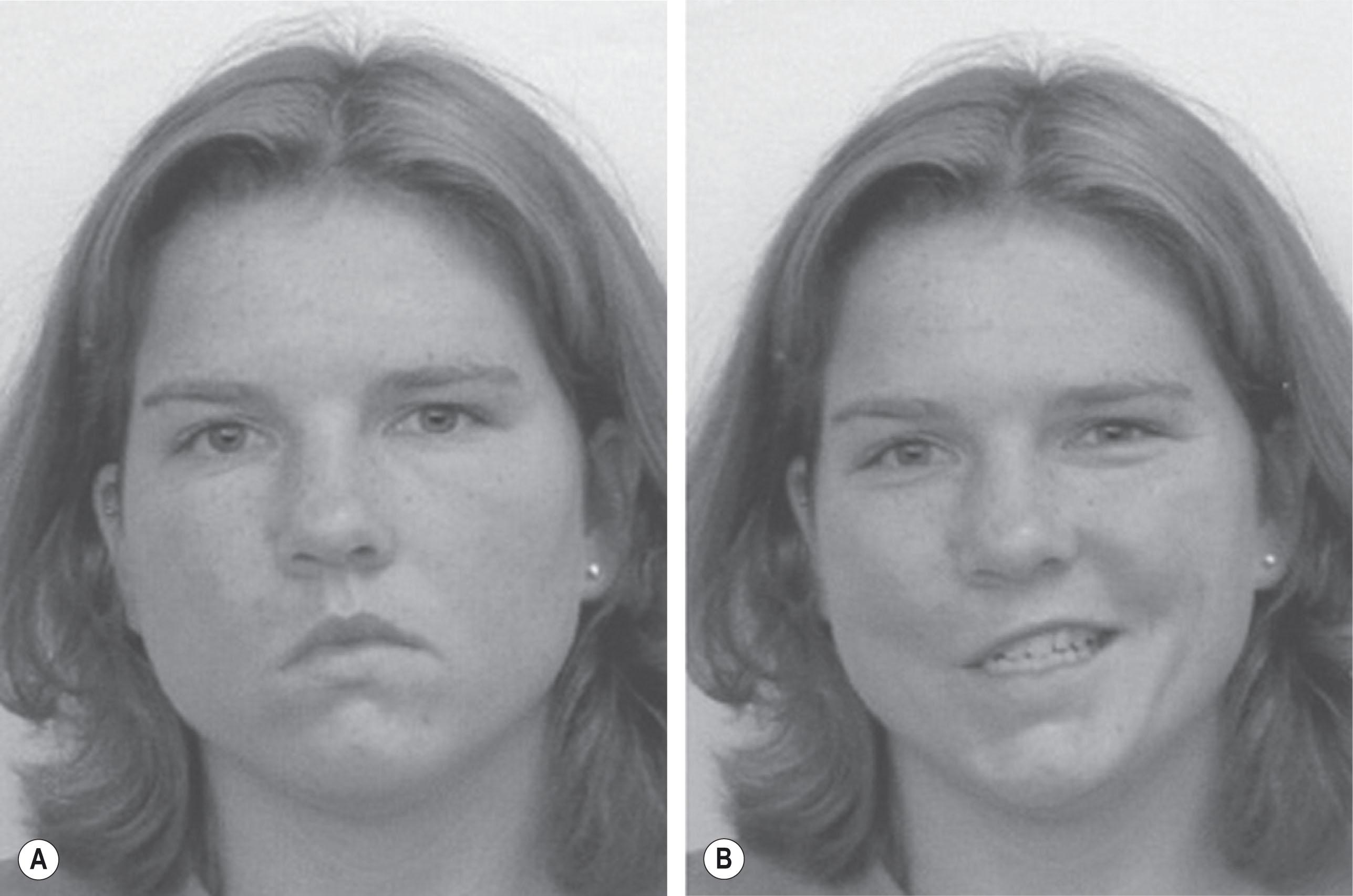
Facial paralysis can be classified by etiology (congenital or acquired), time course (acute or chronic), extent (complete or partial), or anatomically (e.g., unilateral or bilateral paralysis). Of note, the most common form of facial paralysis, with a 1 in 60 lifetime risk, is Bell’s palsy, an acute and usually unilateral form of facial nerve dysfunction that often recovers fully.
Congenital facial paralysis is defined as present at birth. In the pediatric population, this is the most common form of facial paralysis, estimated to occur in approximately 2% of live births. Congenital facial paralysis may be an isolated facial nerve dysfunction or occur as part of a syndrome.
Isolated facial nerve dysfunction may be the result of intrauterine pressure on the facial nerve in the developing fetus. It may also occur because of pressure from the sacral prominence during the birth process or from external pressure on the nerve as it exits the birth canal during the delivery itself. This may lead to a panfacial, buccal branch, or mandibular branch facial paralysis.
Developmental facial paralysis begins during fetal development as a result of an unclear event leading to aplasia or hypoplasia of the cranial nerve nuclei, the facial nerve itself, an aberrant nerve course, or even primary myopathies. Congenital facial paralysis may have a genetic etiology and can occur isolated or in syndromic forms such as the Moebius syndrome (see Fig. 15.25 ). The Moebius syndrome is a rare disorder characterized by usually bilateral non-progressive facial paralysis and the inability to abduct one or both eyes due to impairment in the facial (VII) and the abducens (VI) nerves. The incidence of Moebius syndrome is estimated to be about 1 in 200,000 live births and it may be accompanied by dysfunctions of cranial nerves IX, X and XII, as well as trunk and limb anomalies, the most common of which are talipes equinovarus and hand anomalies. Cranial nerve involvement is usually bilateral and severe but often incomplete with some residual function in the lower component of the face (the cervical and mandibular branch regions).
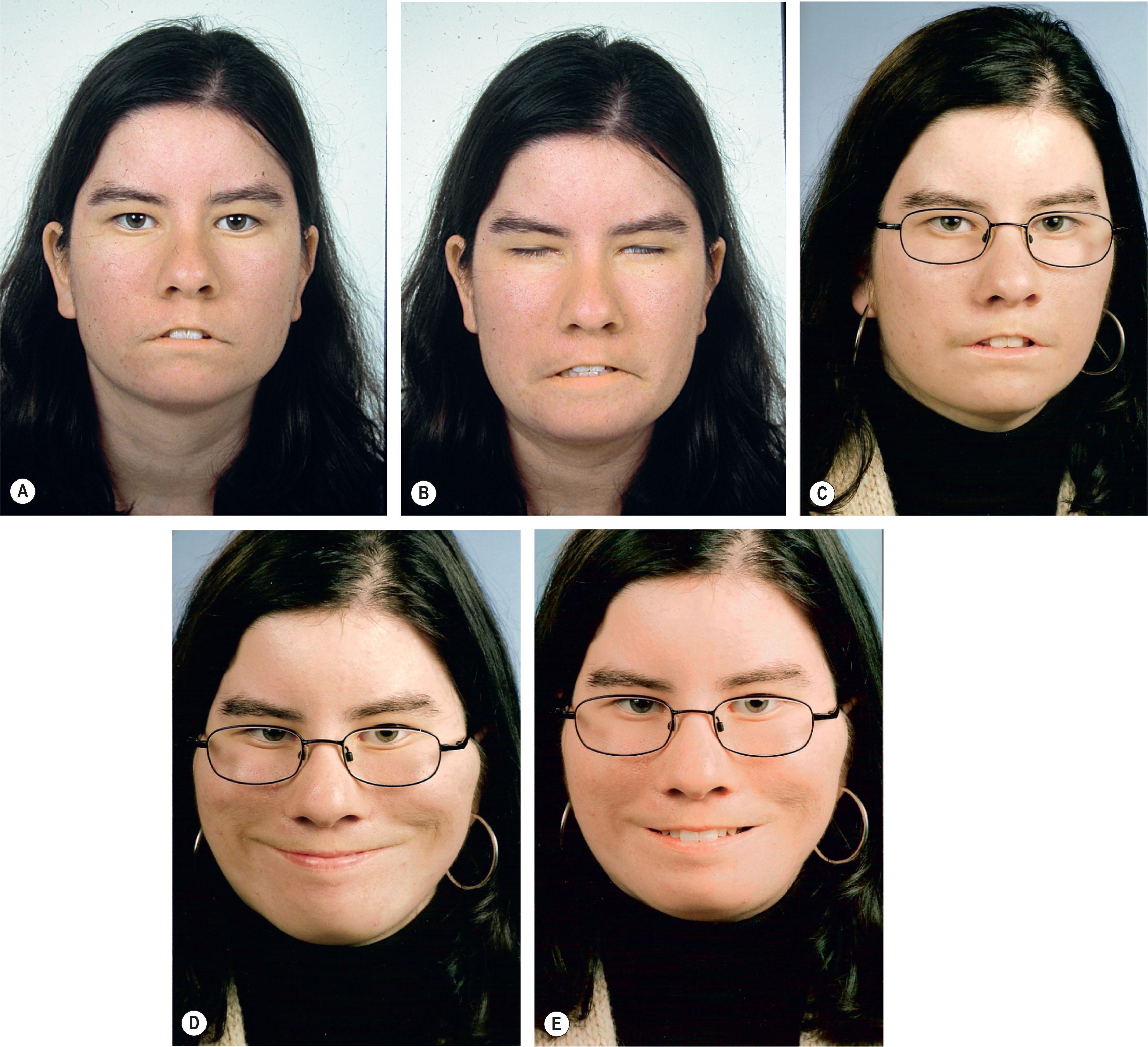
The most common unilateral syndromic condition associated with facial paralysis is hemifacial microsomia. All tissues of the face can be affected to a variable degree, including the facial nerve and the muscles it innervates.
Acquired facial paralysis may result from intracranial tumors, therapeutic procedures (i.e., surgery or irradiation), nerve trauma, infections, or may be classified as idiopathic. Damage to the nerve may occur at any level of the facial nerve from the nuclei to the muscle itself. Acquired forms of facial paralysis may be complete or incomplete to varying degrees, obvious in some patients, and subtle in others ( Table 15.2 ).
| Extratemporal |
| Traumatic |
|
| Neoplastic |
|
| Congenital absence of facial musculature |
|---|
| Intratemporal |
| Traumatic |
|
| Neoplastic |
|
| Infectious |
|
| Idiopathic |
|
| Congenital – osteopetrosis |
|---|
| Intracranial |
| Iatrogenic injury |
| Neoplastic – benign, malignant, primary, metastatic |
| Congenital |
| Absence of motor units |
| Syndromic |
|
Bell’s palsy is the most common form of acquired facial paralysis (or paresis) in adults with an annual incidence of 32 per 100,000 and is considered a diagnosis of exclusion. It usually occurs unilaterally, has an acute onset with a flaccid paralysis, and is isolated to facial nerve dysfunction. It may be interpreted as a stroke-like event. Bell’s palsy affects women and men equally and usually affects all components of the facial nerve. Approximately 85% of patients recover significant function within 3 weeks and 70% regain normal mimic function within 2 to 6 months. The pathophysiology of Bell’s palsy is incompletely understood, however neural or perineural inflammation is likely to play a role as corticosteroid treatment may increase the rate of recovery and the proportion of people who fully recover. However, if the reinnervation process is not satisfactory after six months, functional deficits that remain rarely recover fully. This leaves a subset of patients with long-term sequelae such as reduced or limited facial movement (inadequate muscle excursion), hypertonicity, synkinesis, crocodile tears, altered taste, and decreased tearing. Patients that suffer from severe paresis, hypertonicity, and synkinesis may benefit from non-surgical interventions and in some cases surgery to improve facial symmetry and function. Therapeutic strategies may include focused stretching and exercises, repeated targeted botulinum toxin injections for hyperactive muscles (i.e., every 3 months) or selective neurectomy.
In addition to Bell’s palsy, temporal bone fractures may result in acute, complete loss of facial nerve function due to intratemporal facial nerve injury that can often be challenging to access for surgical repair. However, particularly in longitudinal temporal bone fractures with no displacement, the acute facial nerve dysfunction may be the result of an intratemporal crush injury with axonotmetic and neurapraxic aspects whilst the continuity of the bony canal and the compromised facial nerve may be intact. In such cases, some degree of spontaneous recovery of the neurapraxic facial nerve fiber population is likely to occur within 2 to 4 months, and regenerating axotomized nerve fibers may follow. Thus, after thorough radiologic and electrodiagnostic evaluation, watchful waiting with electrodiagnostic evaluation of facial nerve function after 2 and 4 months post-injury may allow for identification of those patients that don’t require surgical intervention while still providing an acceptable delay for surgical reconstruction in those who do not recover spontaneously. Corticoid treatment early after injury (e.g., prednisolone, 1 mg/kg, for 3 weeks with a subsequent taper to discontinuation for 10 days) may mitigate injury-induced nerve swelling and subsequent compression in the bony canal and thus may facilitate remyelination or neurapraxia and regeneration of axonotmetic axons.
Therapeutic concepts for facial paralysis aim at ocular protection, natural appearance with facial symmetry at rest, and muscle reanimation. Specific treatment goals for the eye and periocular region are to provide ocular surface protection, maintain vision, improve cosmesis, and enable the eye to contribute to emotional expression. The therapeutic goals for the mouth and perioral muscles are to provide oral continence, improve speech, correct asymmetry at rest and restore a balanced and spontaneous smile that the patient will use in social interaction. Accomplishing all these goals is difficult and particularly in severe cases of facial paralysis they may not be completely achievable. Thus, the patient’s concerns, priorities, and expectations for therapy must be sought and patients must be counseled as to what outcomes are realistically achievable. For some, attaining a symmetric appearance at rest is more important than achieving a smile. In comparison to the younger patient, the older patient may be more likely to be worried about brow ptosis, ectropion, and drooping of the cheek. Patients who are appropriately informed and involved in the therapeutic decision-making are more likely to be satisfied with their outcome.
Due to the multifaceted presentation and etiology of facial palsy the therapeutic concept must be tailored to each patient. A detailed medical history focuses on possible etiology (e.g., hereditary, trauma, surgical procedure), time course, predominant functional impairments including nasal airway obstruction, oral continence, speech, ocular dryness, and psychological effects as well as relevant comorbidities. A thorough examination will reveal affected muscles, the degree of dysfunction and ocular involvement. The proximodistal level of facial nerve injury, if it is not known, can be inferred based on the presented nerve dysfunctions. Nerve injury within the temporal bone may result in facial muscle paralysis as well as hyperacusis, partial loss of ipsilateral taste appreciation, and decreased salivation as well as secretion of the nose and lacrimal gland because the chorda tympani and nerve to the stapedius are likely to be involved. Extratemporal facial nerve injuries result in muscle paralysis only. Due to the widespread facial nerve branching, nerve injuries distal to the parotid gland are likely to result in focal muscle dysfunction as other facial nerve branches may remain intact.
Examination of the face begins with the brow. Its position at rest and with movement must be noted. The superior visual field may be diminished by the ptotic brow. The eye must be thoroughly assessed for surface integrity, dryness, and sufficient lid closure. Visual acuity in each eye should be documented. The height of the palpebral aperture should be measured and compared with the non-paralyzed side. The degree of lagophthalmos and the presence of a Bell reflex (upward rotation of the globe during lid closure) will indicate the risk of corneal exposure. The lower eyelid position should be measured, and its tone assessed by the use of the snap test: the lower eyelid is gently pulled away from the globe and released. Normally the eyelid snaps back against the globe; in facial paralysis, however, this may fail to occur. The position of the inferior canalicular punctum should be assessed. Is it applied to the globe or is it rolled away and exposed?
The nasal airway is examined next. Forced inspiration may reveal a collapsed nostril due to loss of muscle tone in the dilator naris and drooping of the cheek. Examination of the mouth and surrounding structures documents the perioral muscle function by assessing the amount of philtral deviation, the presence or absence of a nasolabial fold, the amount of oral commissure depression and deviation, the degree to which the upper lip droops, and the presence of vermilion inversion. With animation, the amount of bilateral commissure movement is recorded; it is also noted how much of the upper incisors show when the patient is smiling. Speech should be assessed. An intraoral examination is performed to check dental hygiene and to look for evidence of cheek biting.
The presence of synkinesis should be documented. Synkinesis may occur over time in patients with facial palsy and is defined as the simultaneous contraction of two or more muscle groups that normally do not contract together. Facial paralysis-associated synkinesis is likely the result of axonal sprouting along the course of the facial nerve at the site of axonal injury. The axonal sprouts may elongate within separate endoneurial tubes that, due to the plexiform architecture of the facial nerve, may lead to different motor branches and thus supply distinct facial muscles. Consequently, activation of the parent neuron population then simultaneously activates two muscles that previously acted independently. This hypothesis is corroborated by electromyographic facial nerve mapping studies revealing aberrant reinnervation pattern in patients with post-paralysis facial synkinesis. Common types of synkinesis are eye closure with smiling, brow wrinkling when the mouth is moved, and mouth grimacing when the eyes are closed.
Other cranial nerves, particularly cranial nerve V, should also be assessed for potential dysfunction. Involvement of other cranial nerves may exacerbate the morbidity of facial nerve paralysis. These nerves should also be assessed as possible donor motor nerves for nerve transfer procedures.
Become a Clinical Tree membership for Full access and enjoy Unlimited articles
If you are a member. Log in here